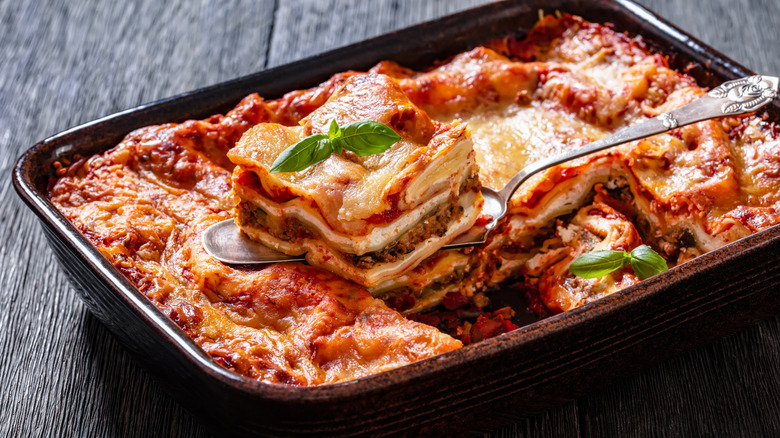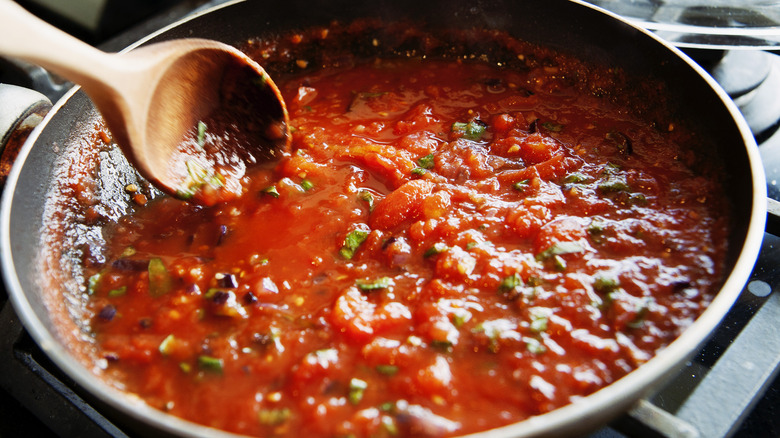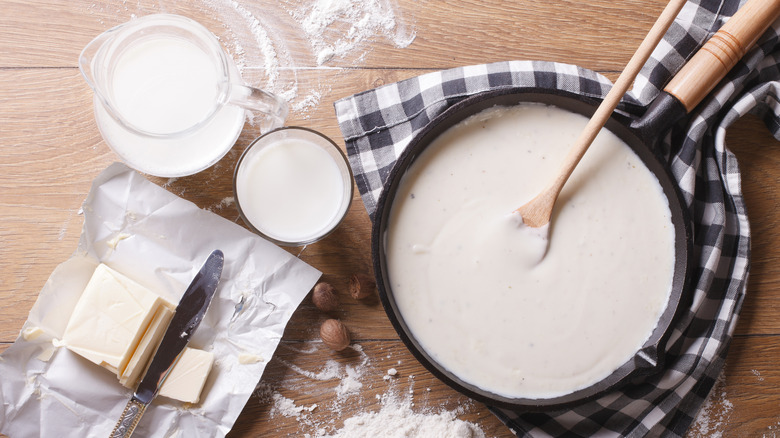The Sauce Tip That Will Save Your Lasagna From Falling Apart
It's a familiar scenario to many of us: You spend over an hour piecing together what looks like the perfect lasagna, only to have it come out of the oven as a soupy mess. Sure, it might taste decent, but after cooking and layering all those ingredients, who would be happy with a mishmash of noodles, sauce, and meat that's more suited for a bowl and spoon than a plate and fork? Don't leave success up to chance — paying more attention to a certain part of your lasagna can reduce sogginess by quite a lot.
An unfortunate soupy texture in lasagna is caused by excess moisture in the ingredients. Thoroughly draining the ricotta cheese you'd use in a classic lasagna recipe or squeezing the cooked spinach you might add to a vegetarian version can definitely help. The biggest offender, though, is watery, thin pasta sauce. A helpful technique can prevent this pitfall from sabotaging your lasagna: Reduce your sauce to thicken it before pouring it into the casserole.
A thin sauce runs right off of cooked lasagna noodles, causing all the layers to slide off of each other, as well. A thick sauce, meanwhile, almost acts like a glue that holds the layers together, resulting in a dish that slices into neat squares. Once you learn how to thicken your favorite sauce recipe, making effortless lasagna for your next dinner party will seem way more doable.
How to reduce your tomato sauce
Reduction involves cooking a liquid to evaporate its water content, reducing its volume and making it thicker. When making lasagna, it's especially important to reduce a sauce made of fresh tomatoes, which have a very high water content. While the process is simple, it does take at least 20 minutes and up to an hour or longer. The cooking time depends on how much sauce you're reducing and how watery it is to begin with.
Whether you use a store-bought sauce or make your own, bring it to a boil, then reduce the heat and simmer on low to medium until the sauce thickens. Leave the lid off the pot so that excess water can evaporate. Reducing the sauce not only makes it thicker, but also concentrates the taste, giving it a more robust flavor. This ensures it will still stand out when layered with cheese, noodles, and more.
To speed up reduction, you can use a wider, shallower pot or pan, or divide up a batch of sauce into multiple pans. More surface area will help the sauce cook down faster. Don't try to crank up the heat, though. Slow and steady wins the race when it comes to the reduction, so keep the stove low and don't let the sauce boil. Check on it periodically, watching out for signs of overcooking, such as a burnt smell or the edges of the sauce appearing hardened and crusty.
Other ways to thicken your tomato sauce
While some cooks might enjoy spending hours in the kitchen preparing the perfect lasagna, others just want great results as quickly as possible. Ina Garten's time-saving tip for lasagna noodles can help you out, and so can a quicker way to thicken your sauce so that it sticks to your noodles. First off, try making a beurre manié and stir it into the pot.
French for "kneaded butter," a beurre manié consists of equal parts softened butter and flour that are kneaded together, then added to warm liquids like soups and sauces. The buttery paste melts when it hits the hot liquid, preventing any flour clumps from forming, while the flour itself performs some thickening magic. After your sauce is done cooking, keep the heat on and add your prepared beurre manié in small increments, until the sauce reaches your desired consistency.
You could also use a roux, a cooked mixture of starch and fat (usually flour and butter). It's a highly popular and equally effective thickening agent. To make a roux, melt butter in a pan, add flour, and whisk until it forms a thick golden brown paste. Add it to your tomato sauce and whisk well to prevent clumping. Another great tip for fixing thin sauces is to add tomato paste. This concentrated product is perfect for thickening your sauce, as well as intensifying the tomato flavor. Just a tablespoon or two ought to do it.


